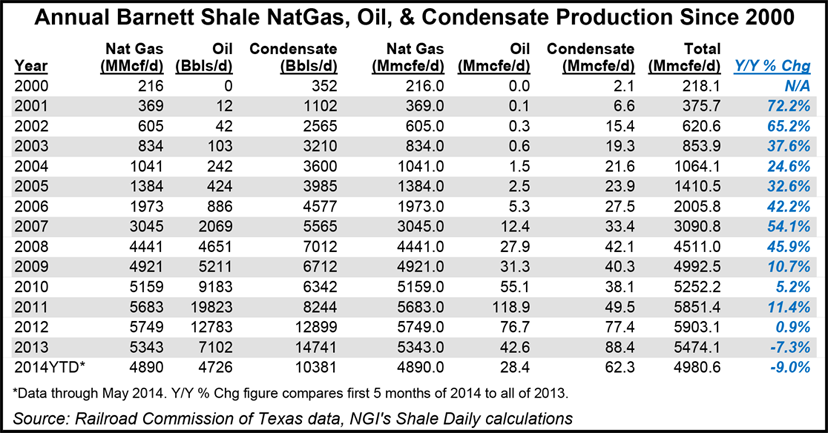Quicksilver’s Barnett Production Up 11%, Starts Drilling in West Texas
Quicksilver Resources Inc. said preliminary results for 2Q2014 show operational efficiencies in the Barnett Shale helped the company boost production volumes there 11% from the preceding quarter, as it also reached an agreement with midstream providers for lower rates.

Meanwhile, the company launched a drilling program in West Texas and executed an agreement to develop acreage in Crockett and Upton counties.
In a statement Tuesday, Fort Worth, TX-based Quicksilver said overall production in 2Q2014 totaled 23.3 Bcfe (255 MMcfe/d), which was a 10.7% decline from the 26.1 Bcfe (287 MMcfe/d) produced during the previous second quarter. But Barnett production was 15.3 Bcfe (168 MMcfe/d).
“Quicksilver’s top goals for the remainder of 2014 remain unchanged and management is extremely focused on unlocking the value in the Horn River, building cash flow in core areas, and addressing the subordinated notes due in 2016,” said CEO Glenn Darden. “In addition, we will push hard to advance our West Texas project and reduce overall company debt.”
Quicksilver attributed the decline in overall production to last year’s sale of an undivided 25% stake in its Barnett assets to Tokyo Gas Co. Ltd. for $485 million (see Shale Daily, April 2, 2013). Another factor, the company said, was a “natural decline in Canadian volumes due to minimal capital activity.”
The company said that late last month it reached an agreement with midstream providers that serve the Barnett for lower rates assessed for gas lift, gathering and processing. Under the agreement, which took effect on June 1, the rate assessed for gas lift was reduced by as much as 65% for volumes originating in the core dry gas areas of the Barnett. Quicksilver said the reduced rate is expected to lower net production expenses by approximately $1.3 million during the rest of 2014, and $2.2 million each in 2015 and 2016.
“Further, in the southern liquids-rich area of the Barnett Shale, the rate assessed for aggregate gathering and processing was reduced by 40% to 45% on new wells completed in the next 24 months, and the lower rates will apply to these wells through the remaining term of the gathering and processing agreement,” Quicksilver said.
In the Barnett, the company said it expects to drill up to 30 gross (16 net) wells and complete up to 47 gross (26 net) wells during the full-year 2014. Quicksilver said a four-well pad on its Texas Motor Speedway lease began flowback during 2Q2014, with a cumulative 30-day initial production (IP) rate of 21 MMcfe/d under restriction. Afterward, the pad had average production of 27 MMcfe/d without restriction.
Quicksilver and its partners, Tokyo Gas and Italy’s Eni (see Daily GPI, May 19, 2009), collectively hold about 135,000 gross (85,000 net) acres of leasehold in the Fort Worth Basin, which includes the Barnett.
In West Texas, the company said it entered into a joint venture (JV) with an undisclosed party involving Quicksilver’s assets in the Midland Basin. The JV calls for Quicksilver to keep a 12.5% stake in applicable acreage in Crockett and Upton counties, which will be carried on both the cost to extend a majority of the leases in the basin and the drilling and completion costs of five wells. An undisclosed third party would operate the five wells.
Quicksilver said the first well with its JV partner Eni targeting the Wolfcamp and Bone Springs formations was started in 2Q2014 and completion operations were underway. A second well is currently being drilled on the JV acreage, approximately 52,500 gross acres in Pecos County, TX.
Elsewhere, on a 7,500-gross acre tract adjacent to the Eni-Quicksilver acreage that was farmed out to an undisclosed operator, a horizontal well targeting the Wolfcamp and Bone Springs was drilled in 2Q2014 and is currently in the completion phase, according to Quicksilver. That followed a vertical test well that was completed in May for core sampling purposed.
“Quicksilver’s portion of the capital for both wells is being fully carried by its partners,” the company said, adding that it was “now focused on approximately 90,000 gross acres in Pecos, Crockett and Upton counties in West Texas.”
The company said it spent about $37 million on capital expenditures (capex) during 2Q2014, including $17 million for drilling and completions, $14 million for leasehold and $6 million for capitalized costs. Quicksilver said bad weather in Alberta delayed plans to drill in Horseshoe Canyon, and some of the deferred drilling there would now be canceled due to low natural gas prices. Full-year capex spending was revised to range from $130-135 million.
Production guidance for 3Q2014 is expected to be 245-250 MMcfe/d, with 85% weighted toward natural gas, and the remaining 15% natural gas liquids and crude oil. Full-year production is expected to average 245-255 MMcfe/d.
Quicksilver reported a net loss of $36 million ($0.21/share) for 2Q2014, compared to net income of $243 million ($1.37/share) during the second quarter of 2013. The company noted that net income for 2Q2013 included a non-operational, pre-tax gain of $333 million related to the Tokyo Gas deal.
Last week, Quicksilver’s Canadian subsidiary, Quicksilver Resources Canada Inc., filed an application with the Canadian National Energy Board to export up to 20 million tons per annum of liquefied natural gas (LNG) from its proposed Discovery LNG project (see Daily GPI, July 29). The project, which would liquefy Horn River gas, would be built near the Campbell River in British Columbia.
Quicksilver said it was continuing discussions with potential partners, including some new ones, over investing in the Horn River project. In the meantime, the company said it anticipates “minimal capital spending” there. Quicksilver holds approximately 140,000 gross (130,000 net) acres of leasehold in the Horn River Basin, which the company believes potentially holds 14 Tcf of natural gas.
© 2024 Natural Gas Intelligence. All rights reserved.
ISSN © 2577-9877 | ISSN © 2158-8023 |
